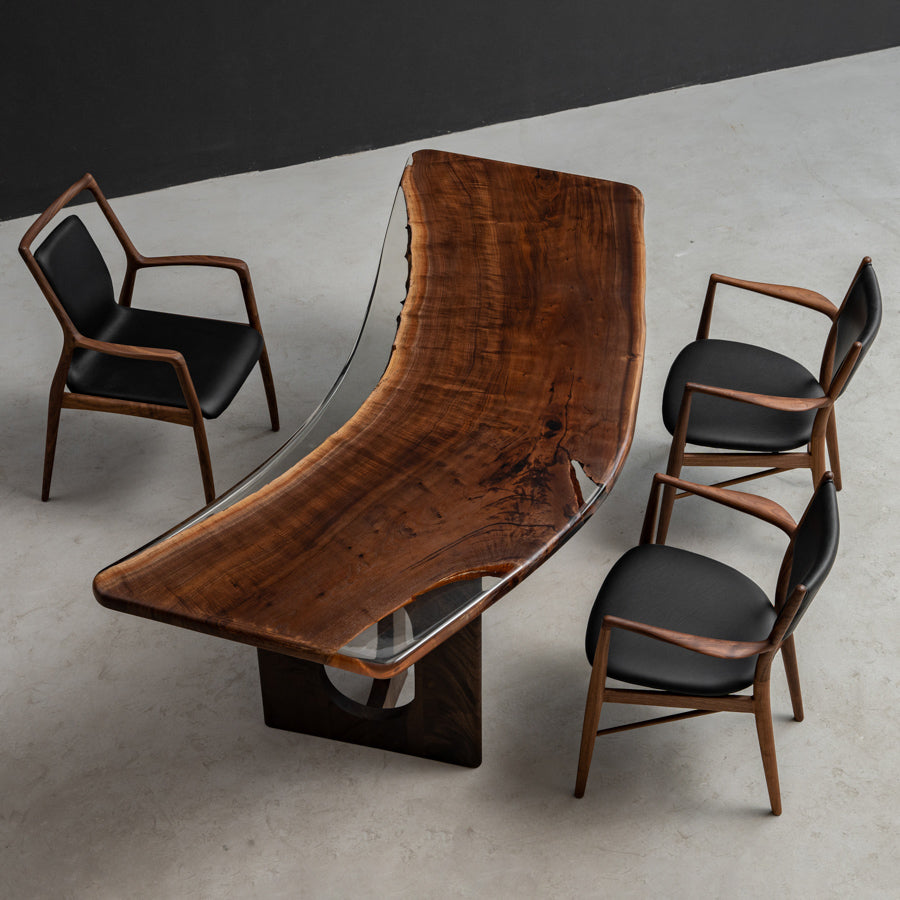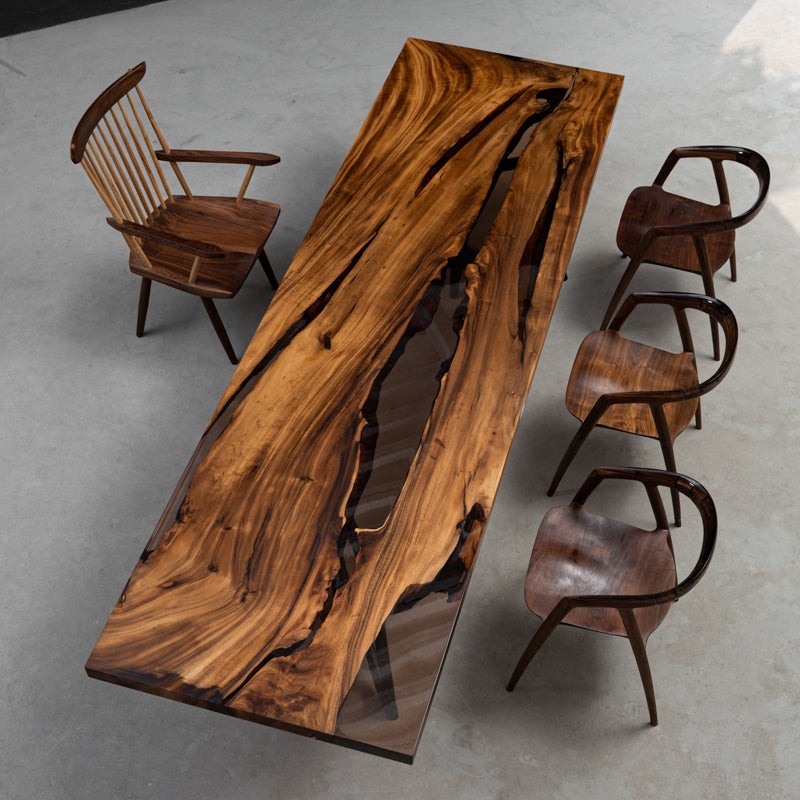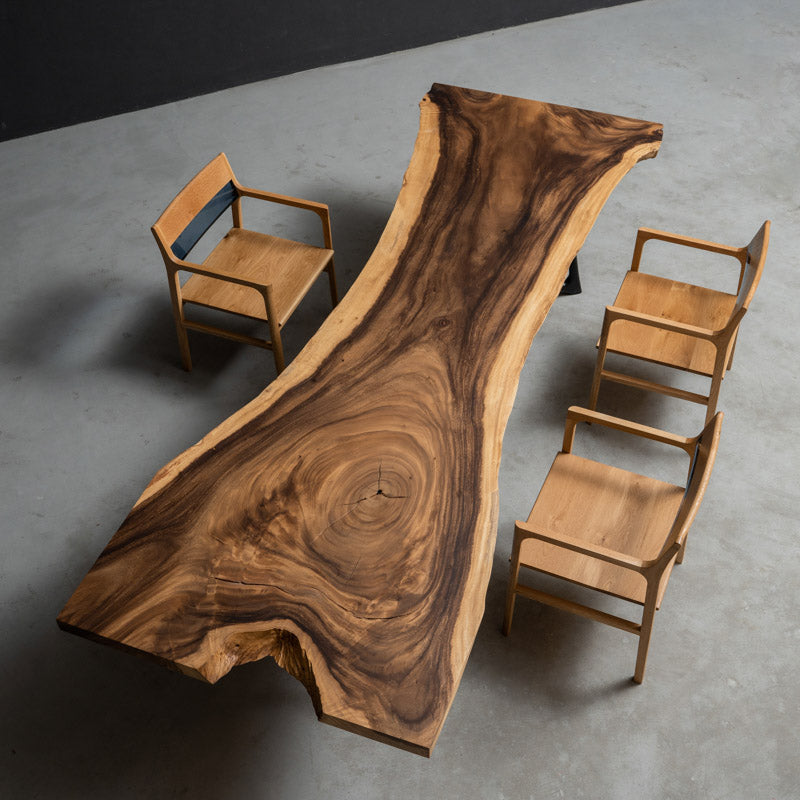
As an indispensable part of daily life, in this issue, we will start with 10 questions to take you deep into the analysis of solid wood dining tables from various dimensions.
- 01 What is a dining table?
- 02 Why do you need a dining table?
- 03 How to choose the size of a dining table?
- 04 Optional materials for solid wood dining tables.
- 05 How to choose the edge style of a solid wood dining table?
- 06 How to choose the table legs for a solid wood dining table?
- 07 What clever design ideas are hidden behind a seemingly simple plank?
- 08 How to choose a dining table that matches different styles of spaces?
- 09 How to maintain a solid wood dining table?

01 What is a dining table?


03 How to Choose the Size of a Dining Table?
The choice of dining table size is diverse and primarily depends on the available space and the number of people. Whether it's a combined kitchen and dining area or a separate dining space, selecting a dining table involves estimating the appropriate size based on the space required for dining chairs.
Choose According to Space
Regardless of the size or shape of the dining table, you should reserve 80cm-90cm of space on the side of the dining chairs to ensure there is enough room for moving the chairs or walking around comfortably.
Choose According to the Number of People
For daily dining in small families of 1 to 3 people, a table length of 100-150cm is sufficient.
For families with around 4 to 6 people, it is recommended to choose a table with a length of 150-200cm.
For larger families with more members, it's best to select a large table with a length of 200cm or more, which is more suitable for spacious homes.

04 Optional Materials for Solid Wood Dining Tables
Wood Using black walnut wood for a dining table provides a subdued and steady color tone, a warm and solid texture, and the bold and natural grain patterns infuse the dining space with a unique sense of luxury while preserving natural charm.
Ash wood has a fresh light yellow wood color and high adaptability to spaces with large white areas. As a dining table, ash wood's soft tones create a relaxed and comfortable atmosphere in the entire dining and kitchen space.
White Oak
Originating from France, white oak wood features a pleasing natural wood color with delicate and elegant grain patterns. As a dining table, it exudes a sense of natural and sophistication, allowing people to unwind and enjoy the dining pleasure in a natural setting.
The pronounced grain patterns of rain wood make it suitable for placement in the dining space. Its moderate color saturation and mild, clear wood grain lines harmonize with the overall atmosphere of the space without appearing obtrusive.

05 How to Choose the Edge Style of a Solid Wood Dining Table?
One of the most attractive features of a large wood table is its irregular and natural edge shape, which preserves the tree's natural curves, presenting the most authentic form of wood.
Straight Edge Design
Clean and sharp 90-degree straight edges are also suitable for placement in right-angled corners, making it a great fit for modern minimalist spaces.
Rounded Edge Design
Creating a rounded edge adds a touch of smoothness and safety to the table, making it suitable for families with children.

06 How to Choose the Table Legs for a Solid Wood Dining Table?
Solid Wood Table Legs
Crafted from imported solid wood, the table legs have bold and natural grain patterns, finely polished edges, and maintain the overall material consistency of the dining table, adding a touch of natural beauty.
Acrylic Table Legs
Designed with the structure in mind, acrylic table legs emphasize proportional symmetry. The high-transparency design gives the appearance of a suspended and high-quality dining space.
Iron Table Legs
Using high-temperature paint technology and meticulous welding and polishing for every detail, iron table legs create a modern and luxurious space when combined with the solid wood tabletop.

07 Hidden Design Ideas in a Simple Slab
Mondrian Series Using irregular wooden blocks of different materials to fill the natural holes left by the tree on a large board, this design creates an abstract visual image resembling Mondrian's art.
This series combines clear resin with a wooden tabletop, blending natural and synthetic elements, balancing the deep character of the wood with a sense of lightness, providing a more breathable atmosphere in home living.
Butterfly Key Patchwork
Design Injecting creative ideas into the patchwork by using butterfly keys with different colors from the single board, adding both stability and visual appeal to the table.
Rounded Edge Design
By employing innovative techniques to process the large board's edge, the table features a unique edge style, whether it's smoothly curved on one side or has large rounded edges on the top and bottom, resulting in a fluid and integral design.
Oxidized White Style Design
A method that reduces the wood's natural saturation without compromising its texture by using an oxidation reduction reaction, resulting in a clean and natural appearance with strong layering.
Modern Vintage Style Design
Enhancing the wood's color through carbonization or chemical processes while preserving the wood's texture, creating a unique deepened color, which adds a touch of vintage charm to the modern space.

08 Choosing a Dining Table That Fits Different Styles of Spaces
Vintage Rustic Style
Vintage rustic style incorporates elements such as imperfections, weathering, fading, and muted tones, creating a space that exudes a primitive, natural, simple, and rugged aesthetic. Low-saturation large boards are the top choice for this style.
Japanese Minimalist Style
This design approach simplifies the space, featuring clean lines and minimalistic decor. It showcases a minimalist home environment with serene and tranquil qualities, making it a great fit for white wax and white oak large boards.
Modern Luxury Style
The modern luxury style emphasizes a simple and elegant design approach, eliminating complex decorations and intricate patterns. It relies on beautiful lines and simple wood elements to express the pursuit of a luxurious design in a subtle manner.
Nordic Cream Style
Balancing comfort and softness with a cool, upscale feeling, the Nordic cream style pairs well with cream or oatmeal colors and a solid wood dining table, creating a romantic atmosphere for dining.

09 How to Maintain a Solid Wood Dining Table?
Solid wood furniture retains the natural characteristics of wood and exchanges moisture with the surrounding air, expanding and contracting in response to changes in relative humidity. To properly care for your large wooden table, consider the following:
Long-Term Absence Care
Solid wood furniture requires careful maintenance, and if it will be unattended for an extended period, be aware that environmental humidity can lead to issues such as cracking. It is advisable to have a friend or family member look after it or check the furniture's condition regularly (every two weeks) and provide appropriate care.
Maintain Indoor Humidity
Solid wood furniture is highly affected by the external environmental humidity. During the winter, using a humidifier indoors or placing a bowl of water inside can effectively balance indoor humidity.
Avoid Direct Sunlight Exposure
Regardless of whether it's summer or winter, you should avoid prolonged exposure to sunlight. Extended exposure can lead to increased dryness in the wood, resulting in cracks and fading.
Cleaning and Maintenance
Prepare some wood wax or olive oil to wipe the tabletop, creating a protective layer that preserves the table's surface. You can also use a specialized maintenance kit for solid wood, like the "Ancient Wood Legends," for wiping and upkeep.
Prevent Direct Heat Contact
During everyday use of your furniture, it's recommended to keep solid wood furniture at least a meter away from heat sources. Prolonged exposure to high temperatures can cause the wood to dry, crack, and deform.










